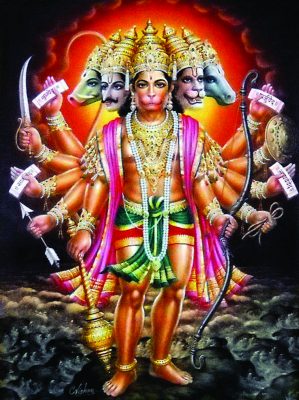The origin of Sri Panchamukhs Hanuman can be traced to a story in Ramayana. During the war between Lord Rama and Ravana. Ravana took help of Mahiravanka who is the king of pathala.
Lord Hanuman in order to protect Lord Ram and Lakshman formed a fortress with his tail. Mahiravana took the form of Vibeeshana and took Lord Ram and Lakshman to pathala loka. Hanuman entered pathala loka in search of Rama and Lakshmana, He found out that to kill Mahiravana he had to extinguish five lamps burning in five different directions at the same time, so he has taken the Panchamukha form with Hanuman, Hayagriva, Narasimha, Garuda and Varaha faces and extinguished the lamps and killed Mahiravana.
According to Hanumath Prakaranam in Sri Vidyarnavatantram, Anjaneya has five faces (Pancha Mukha) and ten weapons. The five faces are that of Lord Hanuman, Lord Narasimha, Lord Adivaraha, Lord Hayagriva, and Lord Garuda. Hanuman is a great yogi (mystic) having transcended the five senses (Pancha Indriyas).
In Kamba Ramayanam (in Tamil), the significance of number five is beautifully narrated as follows:
The son of one of the five elements (son of wind – Pavana Thanaya)
crossed one of the five elements (water – the ocean),
through one of the five elements (sky),
met daughter of one of the five elements (daughter of earth – Sita Devi)
burnt down Lanka by one of the five elements (fire).
Sundara Kandam, which highlights the heroic exploits of Lord Hanuman at Lanka is the fifth canto in the Ramayana. Therefore, it is considered auspicious to go around His idol 5 times, 14 times, 23 times, 32 times or with such numbers the digits of which add to five. The pancha mukha hanuman is rare idol of Hanuman. There are many legends and interpretations to this.
The legend
Lord Hanuman is said to have appeared before Raghavendraswamy in a unique way amalgamating within him the avataras of “varaha, garuda, anjaneya, narasimha and hayagreeva”, thus five-headed. Panchamukhi, located on the south bank of river Tungabhadra near Manchala now known as Mantralayam is where Raghavendraswamy performed penance for 12 long years in a cave. In appreciation of his Yoga, Lord Panchamukhi Pranadevaru, Kollahpura Mahalakshmi, Lord Venkateshwara of Tirupati and Kurmavathara gave darshan to him. Then he left for Mantralaya where he entered into Samadhi. A temple has been constructed at the spot where he performed penance known as the Panchamukhi Anjaneyaswamy temple.
The details of Panchamukaa are:
East facing Anjaneya to grant humanity Ishta Siddhi. South facing Karala Ugraveera Narasimha to grant humanity Abhista Siddhi. West facing Mahaveera Garuda to grant humanity Sakala Sowbhagya. North facing Lakshmi Varaha to grant humanity Dhana Prapthi. Urdhva Mukha {atop} being Hayagriva to grant humanity Sarva Vidya Jaya Prapthi.
The interpretations
There are five ways of prayer to the Lord. They are Naman, Smaran, Keerthanam, Yachanam and Arpanam. The five faces depict these five forms. Lord Hanuman always used to Naman, Smaran and Keerthanam of Lord Sri Rama. He totally surrendered (Arpanam) to his Master Sri Ram. He also begged (yachanam) Sri Rama to bless him the undivided love.
In Bhagavat Gita Lord Krishna says to Arjun, “He who acts for me, who is engrossed in me, who is my devotee, who is free from attachment, he reaches me” . We find all these 5 qualities enshrined in Hanuman. Each of his face explains the five divine qualifications.
May be an artist thought over about this before making the Vigraham. There is a belief that one of the faces is that of Sri Vinayaka. The idol of Adyanta Maha Prabhu depicts a figure of half Anjaneya and half Vinayaka. Half Ganesha and half Hanuman At Madya Kailas temple Adyar Madras The idol is an amalgam of Sri vigneshwara and Sri Anjaneya on the lines of Ardhanareeswara ( Siva and Parvati) and Sri Sankaranarayana (combination of Siva and narayana).
The word Aadiyantha stands for “begining to end” (Aadi = begining & Antha = end). There is a Tamil saying “Begin with Ganesa and end up with Anjaneya”. Many people visit the temple to get blessing of the “Twins” against the influence of Navagrahas. The importance of the idol is that Sri Vigneswara and Sri Anjaneya are the only two deities who are totally free from any influence over them whatsoever by the Navagrahas.
It is believed that, the devotees can and do influence the Navagrahas themselves proportionate to the devoutness with which the devotees address themselves to Sri Aadiyanta Prabhu!
Birth of Hanuman Anjana,
who became the mother of Hanuman Ji, was one of the sixteen matrikas. The matrikas are adored and worshipped ladies of celestial, astral and material planes of the universe.
Once Anjana assumed the form of a lady tourist visiting Svah planet, a few million miles beyond the polestar. She arrived in the assembly of Indra, the king of Svah planet. Some how the king was attracted to her and requested her to make love with him. She rebuked him severely and said, who would like to make love with you, a fallen one with the signs of a thousand eyes!” King Indra could not bear this insult and cursing her, he replied, “You are very vain because of your beauty.
You will be born in the monkey faced Vanara race”. While Indra was cursing Anjana, Anjana’s dearest friend Adrika (out of love for Anjana), tried to insult Indra by meowing like a cat. Indra then cursed her saying, “You will become cat faced in your next life!” In course of time, both friends were born as the twin daughters of Kunja, a Vanara knight.
When they grew up, Keshari, a famous knight of the Vanara race. Married both of them. Then, one day while, Keshari was in meditation at the southern seashore, Maharishi Agastya became the atithi of Keshari.
